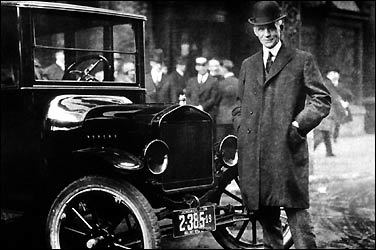Henry Ford Brief History
 |
by Bob Hagin
March 6, 2001
Recently there was an article in an auto trade journal about how the Ford Motor Company is conducting a worldwide search for the first racing trophy the company ever won. It capitalized on the fact that the Ford Motor Company has been actively engaged in auto racing for 100 years and that on October 10, 1901, Henry Ford won a cut-glass punch bowl as a prize for beating Alexander Winton in a 25-mile race at a Detroit horse track. Unfortunately, it was disposed of to an antique shop when Ford died in 1947. "It's probably being used in someone's kitchen," said Edsel Ford II, grandson of Henry Ford, "and we want it back."
That race marked the beginning of the era of Henry Ford, a self-taught engineer who had more to do with shaping our contemporary culture than any other American of the past century. An often used cliche is that "...he put America on wheels.." And while that statement is not entirely true, he can be credited with putting our average citizenry behind the steering wheel.
One hundred years ago, the automobile was a flashy plaything of the rich and only occasionally used for serious transportation. Pioneers like Ford and Winton (he's credited with making the first commercial sale of an automobile in 1897) had to prove their products to a skeptical public and demonstrate that they were devices to be taken seriously. And since the American public was as sports-minded then as it is now, events like the Detroit race captured its imagination.
Ford had no formal training as an engineer, but he fell into it naturally, even though he came from a traditional farming family. Born during the Civil War, Ford was part of the American industrial expansion which held that anyone could become rich and celebrated if he had a good idea and the tenacity to pursue the dream.
Most didn't make it of course. Alexander Winton is now just a footnote in our automotive history. But Ford had one important thing going for him: He worked as an engineer for the Edison Illuminating Company and its founder, Thomas Edison, encouraged Ford to experiment with high-speed, lightweight, self-contained engines. Ford finished his first self-propelled auto in 1897 and legend has it that he had to break down a brick wall in his shed to get it out and onto the street. Although he was married and had a family, he quit his job as chief engineer at Edison to pursue his own dream.
Ford was also a daredevil and in 1904 he took his huge "999" race car onto the ice on Lake St. Clair and established a land speed record of 91 mph. Although the record lasted less than a month, Henry Ford, founder of the huge and prestigious Ford Motor Company, is officially listed as being the fastest man on earth at that time.
Ford initially built his business on his racing reputation. He sold the "999" to the fabled Barney Oldfield, who successfully barnstormed it in match races around the country.
Ford started the Ford Motor Company in 1903 with 11 investors. Ford's partner in the development of the mechanics of those first cars had been a graphic artist and he fashioned the Ford Blue Oval and gave the first letter a particularly fancy flourish. This same logo is used on Ford cars today.
The 1920s were a time of unparalleled posterity in this country and everyone wanted an automobile to show off their prosperity. Although the company made some large and prestigious cars in its early days, Ford made his mark on the automobile world and on the American genre when he introduced the famous Model T in 1908. It was a semi-stark touring car that sold for around $800. It wasn't necessarily cheap compared to some of the slap-dash cyclecars that were on the market but it was affordable and best of all, it was reliable.
The Model T stayed in production until 1927, and while the last version differed greatly from its ancestor of 19 years before, the changes to the car were made through evolution rather than through radical changes. Through Ford's use of the new and revolutionary assembly line technique of mass production, by the mid-'20s, a frugal buyer could by a plain Ford roadster for just a bit over $260.
Henry Ford was a complex and enigmatic person. Although professing to be a populist and a man of the people, he was one of the world's most autocratic capitalists. It was felt by many in his circle of family and friends to have literally hounded his son Edsel to death. He led the industry in paying a "living wage" of $5 per day to his factory workers early on, but as times and economic conditions became better, he brutally put down collective bargaining by the use of goon squads and billy clubs. He was fanatically anti-semitic to the extent of publishing his own monthly magazine to perpetuate his position. He ruled the family-owned Ford Motor Company with an iron hand until well into World War II, when the company was all but moribund. Grandson Henry Ford II had to be called from naval duty to take control of Ford management. Under those war-time conditions, the government was on the brink of taking over the company and its production capacities.
Devil or angel, Henry Ford was and is many things to many people. So search your attic and your basement to see if you have that cut-glass punch bowl inscribed and presented to Henry Ford for his win at that horse track near Detroit nearly 100 years ago. If you find it, you have a pivotal piece of American automotive history.


